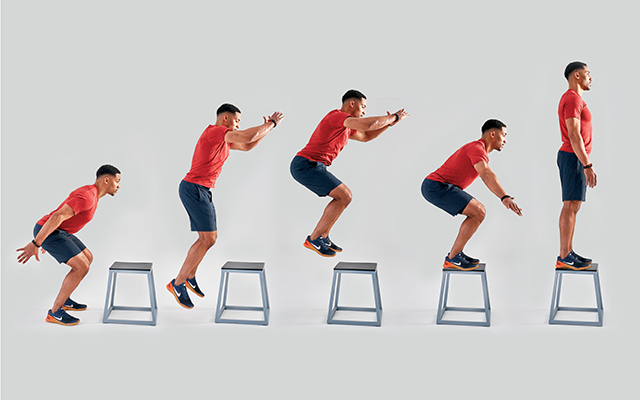In many sports, your level of success is measured in microseconds or fractions of an inch. How often have you just missed returning a tennis stroke or failed to drive by someone on the basketball court because you lacked the necessary speed? If it’s more often than you’d like, your training could probably benefit from plyometrics, a system of high-impact exercise developed by Eastern European Olympic coaches to improve athletic reaction time and high-speed strength.
Plyometric exercise, sometimes known as “jump training,” is highly recommended for those seeking athletic improvement. Because of its jarring intensity, however, it’s not for those with orthopedic injuries or those just beginning a conditioning program. But if you’ve been training for several years, are not significantly overweight and consider yourself healthy and fit, plyometrics can help you refine your athletic skills by increasing the height of your vertical jump, the quickness of your sprints and the explosive power of your fastball, serve or swing.
Done properly, plyometrics also improve joint strength and bone density. They teach you to recover smoothly from jumps and the abrupt movements executed in fast-paced sports. Thus, they can help you avoid sports-related injuries by enhancing your ability to handle high-impact activities.
Plyo Primer
Plyometric exercise trains your body to change direction quickly and powerfully. For instance, when a basketball player drives for a slam-dunk, on his last step before leaping toward the net, his legs must absorb the momentum developed during the run. In a split second, the player stores the horizontal energy of the drive in his legs, and then releases it in an explosive vertical jump.
Plyometric exercise develops this rebound response by taking advantage of a physiological response called the myotactic, or “stretch,” reflex. This reflex causes muscles or tendons, stretched by a sudden movement, to contract in the opposite direction. It quickly stores energy that is then released in a powerful countermovement. And the more energy that’s stored, the more powerful the release.
Think of it in terms of a slingshot being pulled back and then released. The farther you pull it back, the more force you generate. But unlike mechanical devices that can store energy until you’re ready to use them, muscles hold this stored energy only briefly – for about a hundredth of a second. This is why plyometric exercise always involves immediate, explosive reactions.
You can experience the effect of preloading a muscle and then releasing the energy by performing a simple experiment. Try three different jumps.
For the first one, begin with your legs bent at a 90-degree squat position and then leap straight up as high as you can.
Next, start your jump from an upright position, initiate a brief downward movement and then leap explosively. You’ll no doubt jump higher.
Now jump again, but when you land, leap again immediately, as if rebounding. You’ll notice that when you land and leap, the force of the landing rapidly stretches your quadriceps, allowing you to jump even higher. This is plyometrics in action.
Look Before You Leap
As you proceed with the following exercises, keep in mind that this kind of training can involve forces as high as seven times your body weight. Given this, it’s wise to approach plyometrics as a skill-building exercise that relies on quality, not quantity. No more than 20 to 30 percent of your total training program should be devoted to plyometrics, and you should allow 48 hours between sessions. Also, you should never perform these exercises when fatigued. In fact, it’s best to perform your plyometrics before you move on to other exercises. If you’re in doubt, check first with your doctor or trainer.
Warm Up
Warm up for about 15 minutes with submaximal plyo-style exercises, such as power skipping, lunges and medicine-ball tosses. These exercises involve the same muscle groups and movement patterns as those you will use in your training.
- Power Skip: Exaggerated reciprocal-leg to opposite-arm movement with light toe-touch landing that mimics plyometric movements.
- Lunge: Stretches the hips and strengthens the buttocks, hamstrings and quadriceps. Perform in different directions: forward, side-to-side and backward.
- Medicine-Ball Toss: You’ll be performing these as part of your regular plyometric routine, but the goal here is do slow tosses at a light pace to prepare the chest and arms.
Lower Body
Lower-body plyometric exercises apply to most sports that require you to develop maximum force in quick bursts. For example, football and track require horizontal energy. Volleyball demands vertical jumps, and basketball and soccer require quick changes of direction in all planes of movement. Even baseball and tennis have a strong footwork component that can be improved through plyometric drills.
1. Squat Jump: Assume a quarter-squat position (thighs not quite parallel to the ground) with feet shoulder-width apart. Interlock your fingers behind your head. Jump explosively as high as you can and land lightly, allowing your legs to absorb the shock as you return to the quarter-squat position.
At first, try single jumps to learn the movements and then attempt multiple-response jumps: Land and then jump immediately, leaping six to 12 times in a row. Complete three sets with a one-minute rest in between.
Focus on the quality of each jump and try to minimize any lateral or side movement. Your shoulders should align with your knees to support your body’s center of gravity. Land lightly, reducing your impact by flexing your ankles, knees and hips. Ideally, you should land exactly where you took off. When you land, your feet should be nearly flat; although you’ll touch down with the ball of your foot first, the rest of your foot should also make contact to absorb the impact. Spend as little time on the ground as possible, exploding vertically the instant you touch down.
2. Jump and Reach: Follow the same movement of the squat jump, but begin with your hands at your sides, elbows bent and slightly behind the midline of your body. Jump explosively as high as you can, bringing your arms forward rapidly, reaching toward the sky. It helps to have an object suspended overhead to reach toward, such as a basketball rim. When you land, your arms will help develop compressive force by swinging toward the ground. Perform six to 12 repetitions, three sets, with a one-minute rest in between.
3. Split-Squat Jump: Assume a lunge position with your left knee forward at a 90-degree angle. Place your arms at your sides, elbows bent and slightly in front of the midline of your body. Begin with a slight countermovement and then jump explosively using your arms for assistance. While in flight, switch your leg position, bringing the right leg forward and the left leg back to land in lunge position again, with your legs in the opposite position. When you land, rebound immediately. Do not sink into a deep lunge between jumps, as this will hinder the stretch-shortening cycle you’re trying to develop. Complete three to six cycles. Perform three sets with a one-minute rest between each set.
Upper Body
Sports such as golf, tennis and baseball require quick and powerful upper-body movements. Not only can plyometric exercises improve your pitch or swing, they can help prevent injury to your shoulder and elbow joints by strengthening and conditioning the muscles and ligaments. Note: You should do the following only if you are already comfortable with traditional pushups.
1. Plyo Pushup: Assume the pushup position, hands slightly wider than shoulder-width apart and elbows bent. Push off the ground explosively, so that your hands lose contact with the floor, and attempt a clap while your upper body is in midair. Land with your hands in the starting position and immediately push off again. Work up to repeating five to 10 times. Do three sets with a one-minute rest in between.
2. Depth Pushup: Assume the pushup position, but this time with both hands on a 5- to 8-pound medicine ball, elbows fully extended. Quickly remove your hands from the ball and drop down, catching your fall with your hands slightly wider than shoulder-width apart, elbows slightly flexed. Absorb the shock on your wrists and elbows by allowing your elbows to bend and your body to drop into pushup position until your chest touches the ball. Then immediately and explosively push up by extending your arms forcefully. Try to achieve maximum height so your hands leave the ground and then land back on the ball. Repeat the movements immediately three to eight times. Complete three sets, with a one-minute rest in between.
Medicine-Ball Drills
1. Power Drop: Have your partner stand on a 12- to 18-inch-high box (or platform) with a 2- to 8-pound medicine ball. Lie face up on the floor with your head almost touching the box. Your partner holds the medicine ball directly over your outstretched hands. When you’re ready, ask your partner to drop the ball, then catch it with both hands. Allow your arms to bend and the ball to come toward your chest, and then immediately throw the ball back up to your partner. Complete five to 10 cycles. To make the exercise more difficult, increase the weight of the ball or the height of the platform.
2. Medicine-Ball Sit-Ups: You can work the abdominals in plyometric fashion by making your movements into quick bursts of energy that trigger the stretch reflex. Sit on the floor, knees bent, feet flat on the floor, with your partner about 4 feet in front of you. Have your partner throw a moderate-weight medicine ball toward your chest. Catch it in your slightly outstretched hands and allow the force to slightly push your trunk back, as if absorbing the impact. Then immediately recoil, throwing the ball back to your partner with great force. Keep your movements short and quick, and resist the temptation to fold too far back with the ball. Perform five to 10 cycles. To make the exercise harder, increase the weight of the ball and/or the speed of the exchange.



This Post Has 0 Comments